
Mariah Murray
About the Author
Mariah is a young aspiring designer. She develops websites, apps, and other products you might see online. Yet, her special hobby is numismatics and coin design history. In her blog, Mariah shares her insights and shares some recent findings for other enthusiasts and collectors.
Connect with Mariah:



Understanding Sacagawea Dollar’s Price: Should You Expect More Than Its Face?
The new century introduced one of the most striking designs in modern U.S. history—the Sacagawea liberty dollar coin 2000. It aimed to breathe new life into the dollar denomination after the unpopularity of Susan B. Anthony dollar. With over 1.2 billion mints, it became a widespread but underused piece of currency.
Yet beneath the surface lies a hidden truth: 99.9% of them are worth just $1, but the remaining 0.1% —can be worth $1,000 or more. Here is a quick fact: in 2022, a 2000-P Sacagawea/Quarter Mule error stunned the numismatic world by selling for $144,000 at auction.
So, how do you know if your 2000 1 dollar coin is just another piece of metal—or a once-in-a-lifetime discovery? This guide will walk you through everything you need to spot the difference and unlock premium 2000 Sacagawea dollar coin value.
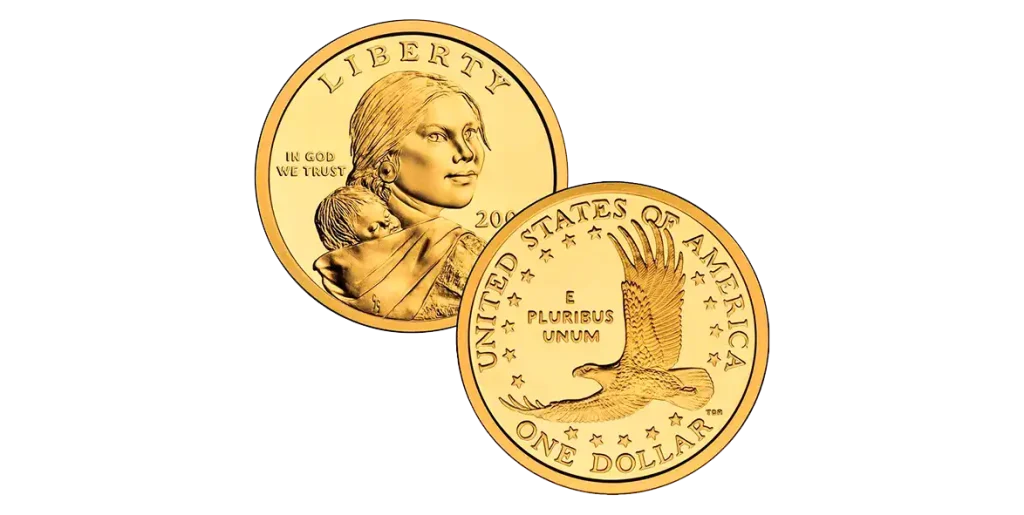
Sacagawea Dollar Fundamentals
The liberty 2000 dollar coin entered circulation as a replacement for the short-lived Susan B. Anthony dollar. Its creators hoped the new design would encourage greater public acceptance and use. The obverse was sculpted by artist Glenna Goodacre and features Sacagawea, the Shoshone woman who assisted the Lewis and Clark expedition.
On the reverse, Thomas D. Rogers placed a soaring eagle, representing peace and freedom. This design remained in use until 2008, after which the Native American $1 Coin Program introduced new yearly reverses.
Is It Made of Real Gold?
Despite its eye-catching golden color, year 2000 dollar coin contains no actual gold. Instead, it has a core of pure copper covered in manganese brass, a metal alloy composed of:
- 77% Copper
- 12% Zinc
- 7% Manganese
- 4% Nickel
This unique composition gives it a golden hue and a distinctive electromagnetic signature used in vending machines. Yet, it means that liberty 2000 one dollar coin value never depends on its melt price
Mint Marks and Where the Money Lies
Understanding the mint mark is one of the first steps in understanding the potential 2000 gold dollar coin value. Each mint mark not only tells you the mintage location but also provides important clues about which rare errors and varieties may be present.
| Mint Mark | Location | Notable Facts |
| P | Philadelphia | 767 million minted. Home of all major 2000-P errors with high one dollar coin 2000 P value (Cheerios Dollar, Mule, Wounded Eagle). |
| D | Denver | 519 million minted. Most are common, though one legendary mule variety exists. |
| S | San Francisco | Struck only as proofs. Not found in general circulation. Higher quality, modest value. |
2000 Dollar Coin Value Breakdown
Most of Sacagawea $1 coin 2000 in circulation are still worth exactly $1. However, uncirculated ones, special editions, and errors can sell for far more—some well into the five- or six-figure range.
| Type/Variety | Typical Value (USD) |
| Standard 2000-P or 2000-D (circulated) | $1 |
| Mint State (MS-60 to MS-65) | $1 – $5 |
| Original Federal Reserve Roll (20 coins) | ~$30 |
| 2000-S Proof | $5 – $10 |
| Cheerios Dollar (Enhanced Feathers) | $250 – $25,000+ |
| Quarter Mule Error | $84,000 – $194,000 |
| Wounded Eagle Variety | $200 – $6,000+ |
| Anthony Planchet Error | Up to $16,800 |
| South Carolina Mule | $66,000 |
Top 5 Valuable Errors & Varieties
Even though more than 1.2 billion 2000 Sacagawea one dollar coin were struck, only a few types are worth serious money. Here are the top five varieties that could make your collection—or your pocket change—something extraordinary.
1. 2000-P Sacagawea Quarter Mule
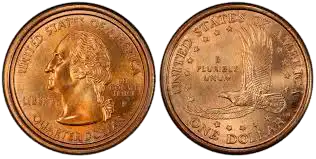
Perhaps the most famous error of the modern era, this “mule” was struck with a Sacagawea obverse and a Washington quarter reverse—something that should never have happened.
- Number Known: ~18–24
- Auction Price Range: $84,000 to $194,000
- How to Spot It: Look for a quarter’s reverse design (eagle or state design) on the back of a gold dollar coin 2000.
2. 2000-P Cheerios Dollar
To promote the new design, 5,500 of 2000 $1 coin samples were inserted into Cheerios cereal boxes. While most looked identical to circulating versions, numismatists later discovered these featured sharply enhanced tail feathers on the eagle, never seen again.
- Low Grade Value: ~$250
- High Grade Value: $25,000+
- Unique Detail: Distinctly separated and pointed eagle tail feathers
3. 2000-D South Carolina Mule
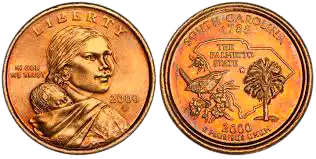
A Denver-minted Sacagawea dollar coin 2000 D that somehow received a reverse die intended for the South Carolina state quarter. Only one of them is known to exist.
- Last Known Sale Price: $66,000
- How to Spot It: Unmistakably mismatched reverse from a South Carolina quarter.
4. 2000-P on Anthony Dollar Planchet
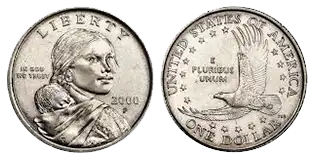
This error occurred when a 2000 one dollar coin P was accidentally struck on a planchet meant for the previous Susan B. Anthony dollar. It’s slightly lighter and smaller than a typical golden 2000 dollar coin P.
- Value Range: Up to $16,800
- Weight Clue: About 7.2 grams instead of the standard 8.1 grams
5. 2000-P Wounded Eagle
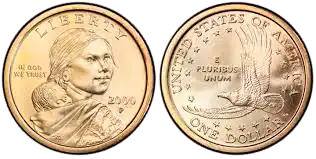
One of the most visually striking errors, this variety features a prominent die crack running across the eagle’s chest, resembling a wound.
- Value Range: $200 – $6,000+
- Where Found: Primarily on liberty one dollar coin 2000 P in uncirculated condition
Mint Mark Analysis: P vs. D
The mint mark is more than just a letter—it’s a key to potentially astronomical one dollar coin 2000 value. If you have a 2000 P Sacagawea one dollar coin, scrutinize it closely—it’s far more likely to be valuable. D’s are generally less rare, but in exceptional condition or as a known mule, they’re still worth checking.
Here is the key info on mint marks that you should remember:
2000-P (Philadelphia)
- Total Minted: 767 million
- Why It Matters: All of the major errors with high 1 dollar coin 2000 P value originated here, including the Quarter Mule, Wounded Eagle, and Cheerios Dollar varieties.
- Exclusive Finds: Only the Philadelphia mint produced the famous Cheerios 2000 P one dollar coin with enhanced tail feathers.
2000-D (Denver)
- Total Minted: 519 million
- Rarity Factor: While one dollar coin 2000 D value is not high in general, a single South Carolina mule error has been discovered from Denver mint—sold for $66,000.
- Top Grades Pay Off: Though typical 2000-D coins hold face value, rare MS-69 graded specimens have fetched $10,000+ at auction.
How Much Is a 2000 Dollar Coin Worth? Step-by-Step Identification Guide
Identifying valuable 2000 Sacagawea dollar coins isn’t just for seasoned numismatists. With a careful eye, basic tools, and the right knowledge, anyone can potentially uncover a rare and valuable variety.
Step 1: Examine the Reverse – Eagle Tail Feathers
The most critical diagnostic feature for identifying a Cheerios Sacagawea dollar coin 2000-p lies on the reverse, specifically in the eagle’s tail feathers.
- Regular 2000-P Dollar: Tail feathers appear flat and softly grouped.
- Cheerios Dollar (Enhanced Tail Feathers): Sharp, well-defined, and individually separated feathers—more sculpted and detailed.
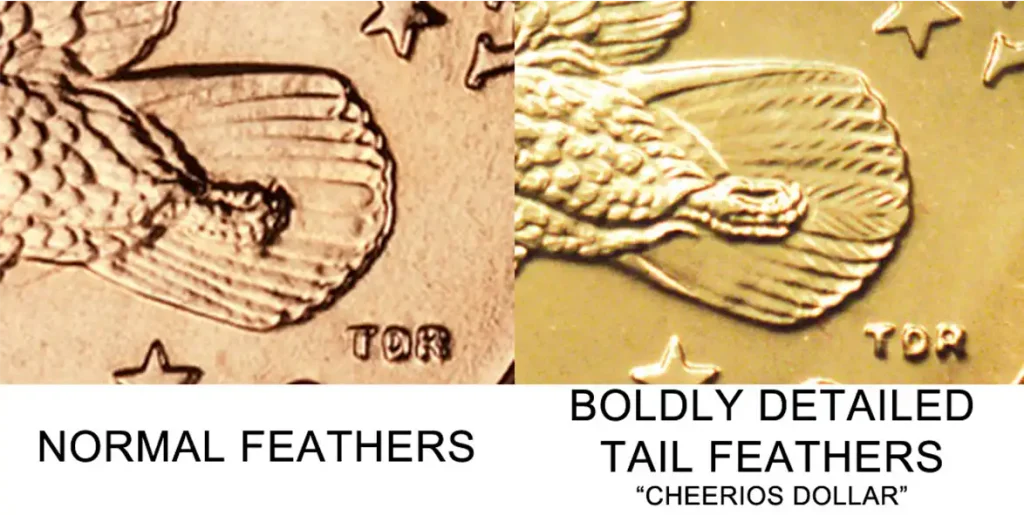
What You’ll Need:
- A 10x loupe or higher magnification
- Good lighting or an inspection lamp
- Reference image of the enhanced tail design (available in numismatic databases or Coin ID Scanner app)
Pro Tip: If your 2000-P coin looks “crisper” on the reverse, especially around the feathers, it’s worth closer inspection. It may be one of the ~5,500 Cheerios Dollars.
Step 2: Weight Check – Spotting Wrong Planchet Errors
The standard weight of a Sacagawea dollar is 8.1 grams. But a small number of 2000-P’s were mistakenly struck on Susan B. Anthony (SBA) planchets, which weigh only 7.2 grams and are visibly paler.
How to Weigh Accurately:
- Use a digital gram scale with 0.01g accuracy.
- If it is significantly under 8.0g and appears silver-toned rather than golden, you may have a 2000-P Anthony planchet error.
| Type | Weight |
| Standard Sacagawea | 8.1 grams |
| SBA Planchet Error | 7.2 grams |
Note: A 0.9g difference is enough to raise red flags. Combine this with visual analysis to confirm suspicions.
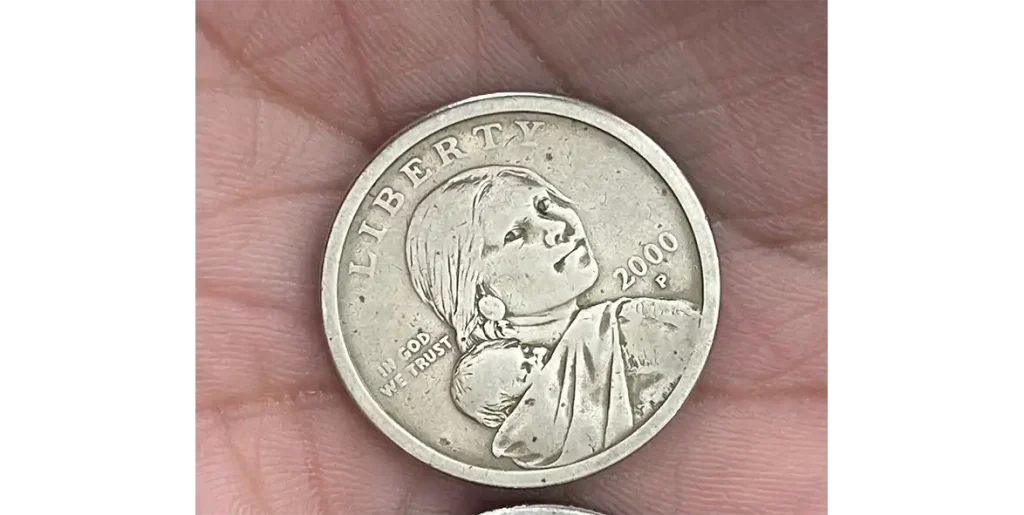
Step 3: Inspect the Edge – Quarter Mule Indicators
The Sacagawea dollar has a plain edge—smooth and unreeded. A quarter, in contrast, features a reeded (grooved) edge. This becomes a critical clue when detecting mule errors.
Mule Identification:
- If your Sacagawea dollar has a reeded edge, it may have been struck with a quarter reverse—suggesting a mule.
- Check the reverse design for a Washington portrait or state design—any non-Sacagawea reverse is highly suspicious.
Important: Don’t mistake vending machine damage or edge nicks for mint characteristics. Mules are flawless in minting and will look clean and intentional.
Step 4: Use Magnification – Spot the Wounded Eagle
The “Wounded Eagle” variety is caused by a die gouge or crack that slices across the eagle’s chest on the reverse, appearing like a wound or slash.
How to Identify:
- The die crack starts near the eagle’s shoulder and runs diagonally across the breast area.
- Best seen under magnification and proper lighting.
| Condition | Value Range |
| Circulated | $200 – $500 |
| Uncirculated MS64+ | $1,000 – $6,000+ |
Tip: If you see a raised line resembling a scar or crack through the eagle’s torso, go to a grading service or submit photos to an appraisal platform.
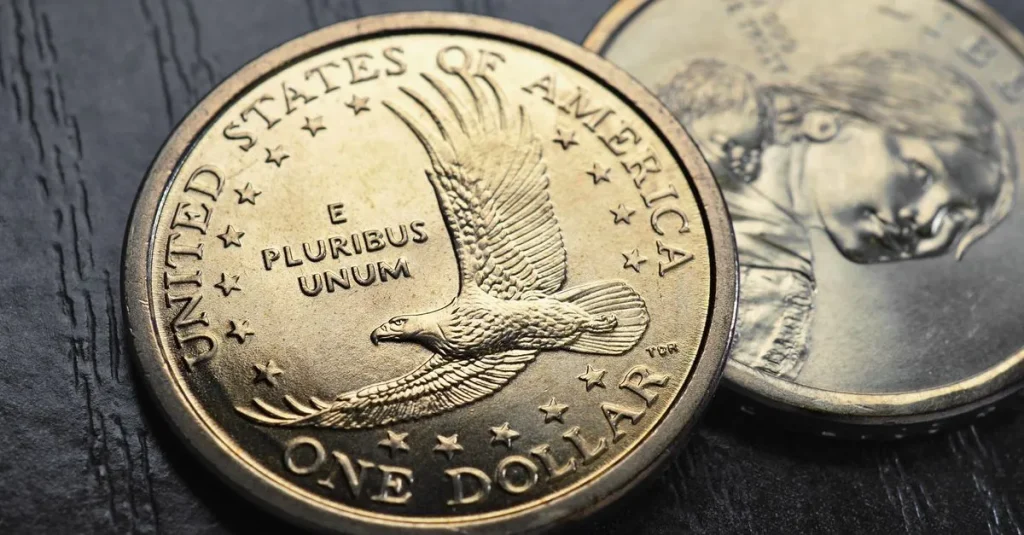
Step 5: Verify the Mint Mark – “P” vs. “D”
The Philadelphia Mint (P) is the epicenter for most of the valuable 2000 errors and varieties.
| Mint Mark | Key Errors |
| 2000-P | Cheerios Dollar, Mule Error, Wounded Eagle, Anthony Planchet |
| 2000-D | South Carolina Mule (only one known) |
- Locate the mint mark: Just below the date on the obverse side.
- If “P” – scrutinize more carefully for signs of high 2000 p dollar coin value.
- If “D” – most likely face 2000 D one dollar coin value, unless you suspect a rare mule.
Step 6: Leverage Technology – Use the Coin ID Scanner App
Even experienced collectors can struggle with identifying microscopic differences. That’s where the Coin ID Scanner app comes in.
Features:
- Visual Recognition: Snap a photo and get instant feedback on known varieties.
- Database Matching: Compares your photo against an extensive error and variety database.
- Value Estimator: Shows approximate retail and auction prices based on grade and rarity.
- Educational Tools: Side-by-side image comparisons, terminology glossaries, and grading tips.
Whether you’re analyzing tail feathers or confirming edge designs, this app can dramatically reduce the guesswork. Especially helpful when dealing with high-value errors that demand verification before sale or submission to grading services like PCGS or NGC.
Final Tips for Home Identification
- Clean hands only: Avoid cleaning—it can drastically reduce one dollar 2000 p coin value.
- Use a white surface and indirect light for easier visual inspection.
- Store safely in flips or holders once you suspect a valuable variety.
- Get a second opinion via collector forums or dealer networks if you’re unsure.
FAQs
How can I tell if I have a Cheerios Dollar?
The Cheerios Dollar features enhanced eagle tail feathers on the reverse. These were specially struck for the Cheerios promotion and exhibit deeply defined, separated feather lines. Compare it using high-resolution images or scan it using the Coin ID Scanner app for confirmation.
What is the rarest 2000 dollar coin?
A: The 2000-P Sacagawea Quarter Mule is the rarest and most valuable. It features the Sacagawea obverse paired with the Washington quarter reverse. Only 18–24 are known to exist, and some have sold for over $190,000 at auction.
Are any 2000-D coins worth money?
A: Most 2000-D’s are common and worth $1. However, one South Carolina mule error from the Denver Mint is known—featuring a mismatched quarter reverse. That single specimen sold for $66,000, becoming the most valuable 2000 d sacagawea dollar coin value.
Where can I get my coin appraised or authenticated?
A: For high 2000 p sacagawea dollar coin value or suspected errors, consider the following:
- Professional Services:
- PCGS (Professional Coin Grading Service)
- NGC (Numismatic Guaranty Company)
- Online Tools:
- Use the Coin ID Scanner app to get instant feedback and value estimates.
- Dealers & Shows:
- Reputable shops and numismatic expos are excellent for in-person evaluations.
Summary: Should You Check Your 2000 Dollar Coins?
Absolutely.
While most 2000 Sacagawea dollar coins are worth just $1, a select few errors and varieties are worth hundreds, thousands—or even over $100,000. It all comes down to details: mint mark, die varieties, planchet errors, and sharpness of design. Whether you’re a dedicated numismatist or a casual hobbyist, the Sacagawea dollar of 2000 is a fascinating and potentially profitable piece of American coinage. And with tools like Coin ID Scanner at your fingertips, finding that golden dollar just got easier.